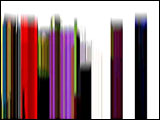
 |
 |
 |
| Computer-based Arts |
Computer-based artistic practices use digital technology to engage in a range of aesthetic activities. Viewers can experience and very often interact with artworks that transform gallery spaces into immersive installation environments, or that take the form of Web sites, DVD-Roms, or artist-developed software run from common desktop computers. These strategies have even become ambulatory, as artists generate projects specifically for mobile phones, PDAs and iPods. What links these practices is the dynamic and often unconventional use and presentation of digital data. The artwork that develops out of these applications of digital technology is also commonly termed "new media" art. However, we have avoided the use of this term here, as it presumes that what is defined as "new" technology in 2006 will remain new in 2026. This section outlines issues relating to the exhibition of computer-based art, including best practices; planning recommendations; examples of agreements; equipment and technical issues; budgetary models, and answers to basic but essential questions. Also included are interviews with key figures, including artists and curators, and a selection of important articles, conference papers and case studies. |